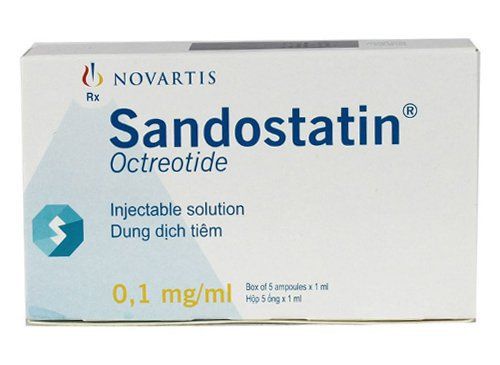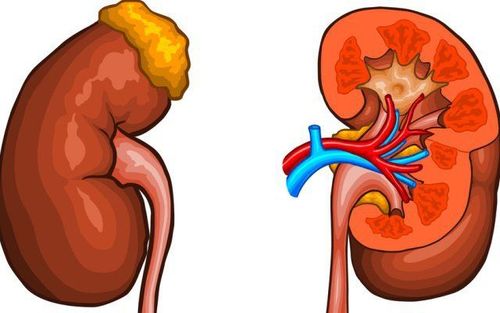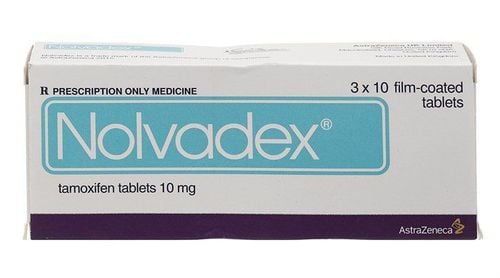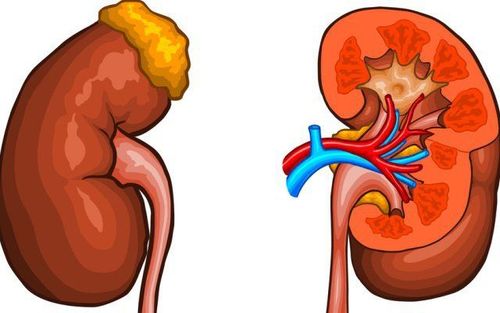This is an automatically translated article.
Soravar with the main ingredient Sorafenib, is an anticancer drug used in the treatment of hepatocellular carcinoma, renal cell carcinoma, and differentiated thyroid epithelium. The following article provides you with information about the uses and uses of Soravar.1. What are the effects of Soravar?
Soravar medicine contains the main ingredient Sorafenib, the drug is prepared in the form of film-coated tablets with a strength of 200mg.Sorafenid is an inhibitor of pre-angiogenesis, which is used in patients with unresectable hepatocellular carcinoma (HCC) without advanced cirrhosis in stages B and C.
Sorafenib inhibits the growth of liver cells. growth of tumor cells in human liver epithelium and kidney cells, in addition, the drug can inhibit some other types of human cancers in allogeneic transplanted mice with compromised immune systems. Decreased vascularity to the tumor and increased programmed tumor cell death were detected in hepatic and renal epithelial cells with the use of Sorafenib. In addition, a decrease in tumor cell signaling was found in the case of human hepatocellular carcinoma.
Sorafenib is an inhibitor of various intracellular (c-CRAF, mutant BRAF, BRAF) and cell surface kinases (KIT, RET, FLT-3, PDGFR-β, VEGFR-1, VEGFR-2) , VEGFR-3). Some of these kinases are thought to be involved in tumor cell signaling, angiogenesis, and apoptosis.
2. Indications and contraindications of the drug Soravar
2.1. Point
Soravar is indicated in the following cases:Hepatocellular carcinoma. Renal Cell Carcinoma: Soravar is indicated for the treatment of advanced renal carcinoma, in patients who have failed prior therapy with interferon-alpha or interleukin-2, or in patients who are not suitable candidates for renal cell carcinoma. these treatments. Differentiated Thyroid Carcinoma: Soravar is indicated for the treatment of advanced, locally advanced or metastatic differentiated thyroid carcinoma (follicular/papillary/Hurthle cell) or refractory patients with iodine radiation.
2.2. Contraindications
The use of Soravar is contraindicated in the following cases: allergy or hypersensitivity to Sorafenib or any component of Soravar.3. How to take Soravar
3.1. Dosage
Soravar is taken orally, swallowed whole with water. It is recommended to take Soravar on an empty stomach, can be taken with a low-fat meal. If the patient eats a high-fat meal, take the drug at least 1 hour before or 2 hours after the meal. The recommended dose of Soravar in adults is 400mg twice a day. When adverse effects are suspected, the use of Soravar can be temporarily stopped or the therapeutic dose reduced. Treatment of advanced hepatocellular carcinoma and renal cell carcinoma, if necessary, the dose of Soravar can be reduced to 400 mg/day. In the treatment of differentiated thyroid carcinoma, if necessary, the dose of Soravar can be reduced to 600 mg/day (in two divided doses, 400 mg and 200 mg orally 12 hours apart). Alternatively, if necessary, reduce the dose to 400 mg/day in two divided doses 12 hours apart. In some cases, the dose of Soravar can be reduced to 200mg/time x 1 time/day. After the adverse effects improve as shown by hematological tests, the dose of Soravar should be increased. The safety and effectiveness of Soravar in patients under 18 years of age have not been established. Elderly patients (>65 years): No dose adjustment is required. Patients with renal impairment: No dose adjustment of Soravar is required in patients with renal impairment. Fluid and electrolyte balance should be monitored in patients at risk for renal dysfunction. Patients with hepatic impairment: No dose adjustment of Soravar is required in patients with Child-Pugh A and B (mild to moderate) hepatic impairment. There are no data on the use of Sorafenib in patients with severe hepatic impairment Child-Pugh C.3.2. Soravar overdose and treatment
The highest dose of Sorafenib in the study recorded was 800 mg twice daily. Symptoms noted with the use of Sorafenib at this dose are diarrhea and skin reactions.In case of suspected drug overdose, stop using Soravar and apply supportive measures. There is no specific antidote for sorafenib overdose.
4. Undesirable effects when using Soravar
The most serious adverse effects when using Soravar are myocardial infarction, hypertension, drug-induced hepatitis, gastrointestinal perforation, bleeding.The most common side effects are fatigue, infection, hair loss, skin reactions, rash, diarrhea. When using Soravar, there may be some undesirable effects as follows:
Very common: Infection, lymphocytopenia, anorexia, hypophosphatemia, bleeding (brain hemorrhage, gastrointestinal tract, blood sugar). respiratory), hypertension, diarrhea, nausea, vomiting, constipation, arthralgia, fatigue, pain, fever, weight loss, increased amylase, increased lipase. Common: Folliculitis, leukopenia, neutropenia, anemia, thrombocytopenia, hypothyroidism, hypercalcemia, hypokalemia, hyponatremia, depression, taste changes, tinnitus, congestive heart failure, ischemic and myocardial infarction, runny nose, dyspepsia, dysphagia, gastroesophageal reflux disease, dry skin, rash, hair loss, skin redness, itching, kidney failure, protein urinary retention, erectile dysfunction, asthenia, transient elevation of transaminases. Uncommon: Hypersensitivity reactions (including skin reactions and urticaria), anaphylaxis, hyperthyroidism, dehydration, reversible posterior leukoencephalopathy, hypertensive crisis, interstitial lung disease (pneumonia, radiation pneumonia, acute respiratory failure), pancreatitis, gastritis, gastrointestinal perforation, hyperbilirubinemia and jaundice, cholecystitis, cholangitis, keratosis pilaris, squamous cell carcinoma, exfoliative dermatitis, sloughing, hyperkeratosis, gynecomastia, transient elevation of blood alkaline phosphatase, abnormal INR, abnormal prothrombin levels. Rare: Angioedema, QT prolongation, drug-induced hepatitis, erythema multiforme, rhabdomyolysis, nephrotic syndrome.
5. Some notes when using Soravar
Skin Toxicity: Rash is the most common adverse effect of Sorafenib, usually occurring during the first six weeks of treatment. When experiencing these symptoms, it is possible to apply local treatments to relieve symptoms, temporarily stop treatment or adjust the dose of Soravar, in severe cases, Soravar can be stopped. Hypertension: Mild to moderate elevation of blood pressure, usually occurring very early in the course of treatment. Monitor blood pressure regularly while using Soravar. In the case of severe or persistent hypertension, or a hypertensive crisis despite antihypertensive therapy, permanent discontinuation of Soravar should be considered when necessary. Bleeding: An increased risk of bleeding may occur when taking Soravar. If bleeding occurs while taking the drug, permanent discontinuation of Soravar should be considered. Ischemic or Myocardial Infarction: Consider temporary or permanent discontinuation of sorafenib in patients with ischemia or myocardial infarction. Prolonged QT interval: The QT interval may be prolonged with Soravar, leading to a risk of ventricular arrhythmias. Caution should be exercised in patients at risk of QT prolongation such as: patients with congenital QT prolongation syndrome, treated with high doses of anthracyclines, taking antiarrhythmic drugs or other drugs known to prolong the QT interval, disturbances. Electrolyte disturbances such as hypokalemia, hypocalcemia or hypomagnesaemia. When using Soravar in this patient, monitor the electrocardiogram and electrolytes during treatment. Hepatic Impairment: Sorafenib is eliminated primarily by the liver, and should not be used in patients with Child-Pugh C (severe) hepatic impairment. Concomitant use with Warfarin: Regularly monitor prothrombin time, INR or clinical symptoms of bleeding when Soravar and Warfarin or Phenprocoumon are used concomitantly. Elderly: Renal function should be monitored when Soravar is used in the elderly (> 65 years). Pregnancy: Do not use Soravar during pregnancy. Soravar should be used with caution in pregnant women, if the potential benefit outweighs the potential risk to the fetus. Women of childbearing age: It is not recommended to become pregnant during treatment with Sorafenib. Physicians should counsel patients who are women of reproductive age about the risks to the embryo, including teratogenicity, fetal underdevelopment, or stillbirth. Use birth control during treatment with Soravar and for the next 2 weeks after stopping it. Fertility: Animal studies have shown that sorafenib may impair fertility in both males and females. Lactation: It is not known whether Sorafenib is excreted in human milk. Since the effect of Sorafenib on the nursing infant cannot be excluded, women should discontinue breastfeeding while taking Soravar.6. Drug interactions
Docetaxel: Concomitant use of Sorafenib and Docetaxel may increase Docetaxel concentrations. Induction of CYP3A4: Concomitant administration of sorafenib with rifampicin may result in decreased concentrations of sorafenib. Other inducers of CYP3A4 activity (such as Carbamazepine, Phenytoin, Phenobarbital and Dexamethasone) may increase the metabolism of Soravar, thereby reducing blood concentrations of Sorafenib. Doxorubicin: Concomitant treatment with Sorafenib increased the AUC of the drug by approximately 21%. Neomycin: Concomitant use of Soravar with Neomycin, will affect the enterohepatic reabsorption cycle of sorafenib, thereby reducing the absorption of Sorafenib.
Please dial HOTLINE for more information or register for an appointment HERE. Download MyVinmec app to make appointments faster and to manage your bookings easily.













